Goldsmith's work
| Goldsmith's work | ||||
|---|---|---|---|---|
| In the national inventory | ||||
|
Practitioners and people who know the tradition well
Goldsmiths and jewelry makers practice their profession throughout the country. Currently, education in the field is provided in nine secondary-level institutions and at the higher education level in two institutions. Traditional apprenticeship options also exist, where knowledge is passed down from a master to an apprentice. However, the Finnish National Agency for Education (Opetushallitus) has established regulations and course requirements for apprenticeship learning.
With the exception of a few larger producers, goldsmiths in Finland are primarily micro-entrepreneurs who operate either independently or in small collaborative workshops. Jewelry is made from a variety of materials today, but in this context, we are discussing traditional goldsmithing work and techniques. The level of expertise in Finland is still relatively good, but reductions and cost-cutting measures in craft education have resulted in insufficient training time for goldsmiths to acquire their professional skills. Post-graduation, gaining experience and honing their craft has become the responsibility of the students, which can pose difficulties, for example, in job searches when the skill level does not meet the employer's expectations. Naturally gifted and motivated students seek the missing knowledge and experience, but overall, it can be observed that professional skills have declined.
Organizations such as the Finnish Goldsmiths' Association (Suomen Kultaseppien Liitto ry), the Finnish Silversmiths' Association (Korutaideyhdistys Suomen Hopeasepät ry), and Ornamo play a role in supporting practitioners of the profession, as well as the preservation and development of tradition. Social media loosely connects professionals in the jewelry field, where knowledge is shared from one professional to another. In some cities, there are still Goldsmiths' associations, but their significance has diminished over the last 15-20 years.
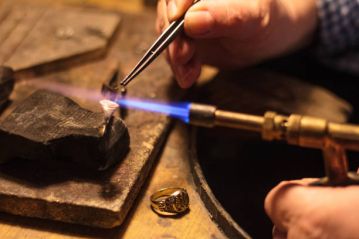
The Finnish Museum of Horology and Jewelery Kruunu (later Kruunu) records, researches, and presents tradition through exhibitions. Kruunu's mission is to open up the meanings of the watch and jewelry industry. According to their strategy, the museum Kruunu is responsible for the documentation of the history of time measurement, concepts of time, cultural heritage related to watch and jewelry industries, including usage and habits (identity), manufacturing techniques and tools, design, art, and company history,
phenomena, stories, and memories, images, media, archive materials, watches, and jewelry.
Practising of the tradition
The introduction of new materials and technology into the field of jewelry has revolutionized and diversified the world of jewelry.
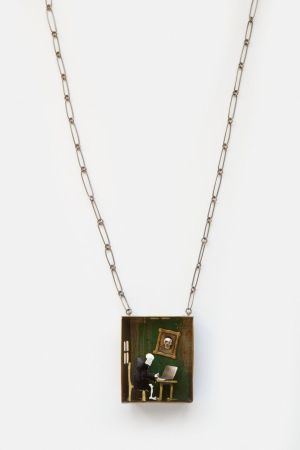
The significance of raw materials has also changed. Gold and silver are no longer the only options; plastics, veneers, and many other materials have found their way into the world of jewelry. This has given rise to a new generation of jewelry makers who no longer rely on the traditional goldsmithing techniques. For this reason, it is becoming increasingly important to preserve the millennia-old cultural heritage of the goldsmithing profession so that the knowledge can be passed on to future generations in its entirety. Today, those who practice this tradition are primarily small business owners with training in goldsmithing, who handcraft and repair jewelry for their clients.
One unique aspect of Finnish goldsmithing tradition is that goldsmiths themselves set gemstones. In other parts of the world, it is common for gem setters to be a separate profession responsible for attaching gemstones to jewelry, while goldsmiths create the precious metal settings for the gemstones.
Jewelry is an intriguing and meaningful form of self-expression. A piece of jewelry tells a story not only about its maker but also about its wearer. Many different types of jewelry courses, such as chain weaving, are offered in adult education centers (kansalaisopistot). This activity is essential because through hobbies and crafts, awareness and interest in the field and its tradition spread to broader circles. Museum Kruunu occasionally includes demonstrations in its program. Large jewelry manufacturers have also conveyed an image of the goldsmith's workbench to their customers in their marketing.
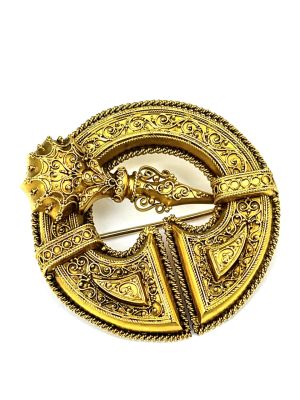
In large companies, casting technology is often used for production reasons. This allows for the streamlining of processes, and even labor-intensive and demanding gem setting can be incorporated as part of the casting process.
Working methods vary between small workshops and industrial processes. This is reflected, for example, in variations in surface treatments. Small-scale manufacturers and entrepreneurs tend to design more individualized jewelry compared to the industry, which produces large jewelry series that may be manufactured for several years.
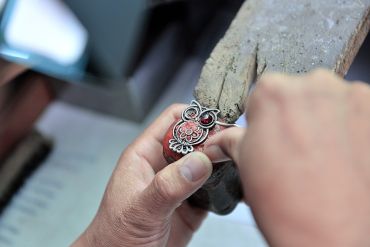
In practice, jewelry can be divided into three categories, with differences in design and production methods. These categories are sold through different distribution channels, and the users may also differ:
· Design > industrial mass production, retail stores
· Handcrafted > goldsmiths, master craftsmanship, own workshop and store
· Art > jewelry art, own workshop, galleries, exhibitions
Competitions, trade shows, and other craft events are also crucial platforms where goldsmithing traditions become visible. For example, wedding fairs have become important places for presenting the goldsmithing industry.
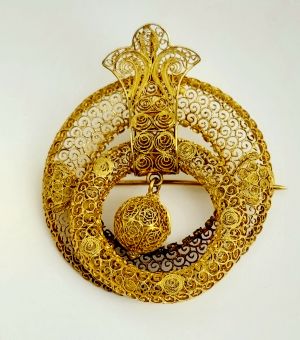
The background and history of the tradition
The goldsmithing craft is a tradition that spans thousands of years. While the methods and tools have remained quite similar over time, the introduction of machinery has facilitated many aspects of the craft. In the guild system, the industry trained its workers through the master/apprentice method and thus controlled both the quality and the level of expertise, which was considered sufficient craftsmanship. Today, schools and industry professionals bear the responsibility for passing on this tradition. However, due to the significant reduction in training time, there is concern about whether the tacit knowledge and skills will be passed on to the next generation to the extent that they have been and should be.
Hobby activities in the field of jewelry making are quite common. Almost all community colleges offer some form of jewelry courses, and goldsmiths themselves have become active in offering small-scale courses to their customers. This phenomenon, which has gained great popularity, is important as it introduces hobbyists to the demanding and multifaceted nature of the goldsmith's profession.
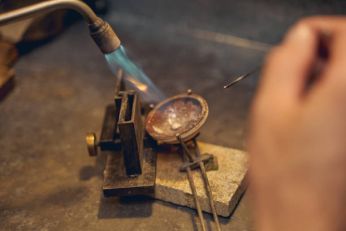
An essential part of the Finnish goldsmithing tradition is the legacy of Fabergé from St. Petersburg. Most of the master craftsmen at Fabergé were Finns, and after the revolution, the goldsmithing tradition of St. Petersburg was brought to Finland by emigrants. In goldsmithing schools, teachers who had learned their craft in St. Petersburg served as instructors, and this tradition has continued to the present day, primarily in schools in Lahti. One unique aspect is that slightly different techniques were used in St. Petersburg compared to the rest of Europe.
The transmission of the tradition
Today, the tradition is primarily passed down through vocational education. While in the past, knowledge was transferred from master to apprentice, now it is passed from teacher to student. The biggest challenge in preserving the tradition lies in the shortening of the educational period, where the allotted time may not be sufficient to attain the required professional competence and experience. There are still experienced teachers with a wealth of knowledge and skills, but new and future teachers often enter their roles with significantly less knowledge and skills. This naturally leads to a weakening of the transfer of tradition and tacit knowledge.
The future of the tradition
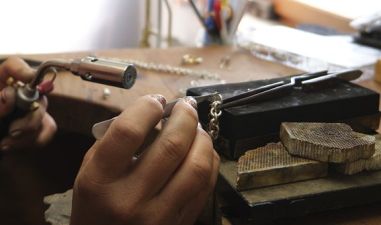
Tradition is experiencing significant change in the age of digitalization. New methods enable the production of jewelry through digital applications even for those without formal training in goldsmithing, which blurs the consumer's perception of traditional craftsmanship. In society, the transformation of tradition is evident in various ways, such as the diminishing importance of precious metals in jewelry production, the rapid cycles of the fashion world, and the growth in jewelry production volume due to industrialization. However, there are two user groups among jewelry wearers. There are those who value and wear classical precious metal jewelry, and there are those who wear flashy mass-produced fashion jewelry. This diversity makes it increasingly important for custodians of tradition to emphasize skills, values, and quality in the face of stiff competition from industrial "copies."
The community/communities behind this submission
Finnish Museum of Horology and Jewerely Kruunu
Bibliography and links to external sources of information
Online sources (links checked on 12.10.2023)
Sarah Laukkanen, "Kultaseppien liitto: Suomalainen koruvalmistus uhkaa siirtyä ulkomaille" Yle 10.11.2017
Suomen kello- korumuseo Kruunu, "Kultasepäntyö ammattina" 5.10.2020
Tuija Vierto, "Kultaseppien grand old man arvioi nykykoruja: "Niissä elää Fabergén henki" – katso kuvat taiturimaisista koruista" 28.10.2018
Mikko Tuomikoski, "Suomi sai uudet "kruununjalokivet" – Jenni Haukio kantaa kaulallaan korua, jolle ei voi laskea hintaa" 31.5.2017
Heikki Rönty, "Korun arvo muodostuu tunteesta – eikä uusi tekniikka sitä ainakaan vähennä" 25.8.2016
Kello- ja korualan tietopankki, kasvava ja kehittyvä alusta jonne kuka tahansa voi lisätä tietoa ja kuvia.
Videos
Henrik Kihlman: Hopeaseppä mestari
Suomen kello- ja korumuseo Kruunu, Suomalaisen spektroliittikorun valmistusta 16.4.2020
Love Mandala, "Jewelry making process. Enamel making." 15.6.
Bibliography
Guld och Silversmeder i Finland 1373 - 1873, Tyra Borg
Fabergé ja hänen suomalaiset mestarinsa, Ulla Tillander Godenhielm
Itsenäisyyden ajan suomalainen koru, Helena Pahlman, Lars Pahlman, Tuula Poutasuo, Päivi Ruutiainen, Ulla Tillander-Godenhielm, Esko Timonen
Kultasepän käsikirja 1945. Toimittanut Uuno V. Aarne ja L.M. Viherjuuri.
Suomalaisen kultajahopeasepäntyön historian bibliografia, Koonnut Visa Immonen (sisältää 44 sivua alan kirjallisuutta)
Suomalaisia Antiikkikoruja, Raimo Fagerström, wsoy, 1989
Doctoral theses
Onko puhelinkoppi koru? Nykykoru taiteen kentällä. Päivi Ruutiainen.2012. Lapin yliopisto.
Arjen Trilogia. Korutaide taiteen tekemisen ja kokemisen välineenä. Petteri Ikonen.2004. Taideteollinen korkeakoulu.
Women and jewelry. Asocial Approach to Wearing and Possesing Jewelry. petra Ahde-Deal.2013 Taideteollinen korkeakoulu.
Kertomuksi akulatseppien yrittäjyydestä Kaisa Hyrsky. 2021 Helsingin Yliopisto. Käsityötiede.
The Imperial Russian Award System 1894-1917. Ulla Tillander-Godemhielm.2005. Helsingin Yliopisto.
Korualan koulupolku. Taike. Heli Kauhanen.
Textbooks
Kivenistutus. Jalokivien istutus kulatsepän työssä, 2013. 3. uudistettu painos. Immo Lahtela.
Hopeasepän pajasta. Heikki Seppä. OPH. 1999.
Kultasepän aineoppija ammattikemia. pekka Vaissi ja Hannu Huovinen. OPH. 2009.
Kultasepän jalokivioppi. Esko Timonen.
